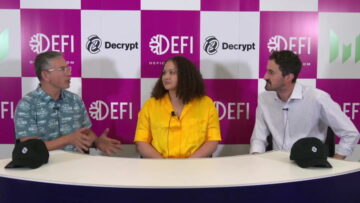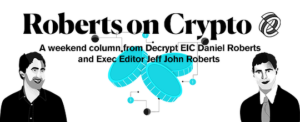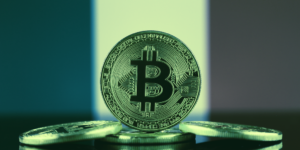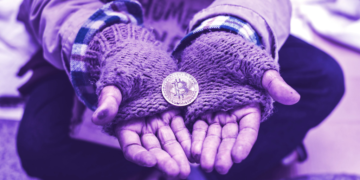
In brief
- A DAO, or decentralized autonomous organization, is a business structure where control is spread out rather than hierarchical.
- DAOs are organized using smart contracts, with participants using governance tokens to vote on topics such as fund allocation.
Ever feel like your boss doesn’t listen to you? It’s a common gripe at work. A new type of organization is changing that, with a flatter management structure, and a set of rules automatically enforced on a blockchain.
Decentralized Autonomous Organizations (DAOs) allow everyone to take part in discussions, encouraging teamwork. And they’ve created some pretty cool things.
What is a DAO?
A DAO is a business structure where control is spread out, across the team members instead of being centered around one authority figure.
A DAO can be seen as operating like a machine, with the job it is instructed to carry out determined by pre-written smart contracts.
How do DAOs work?
A community can adapt a DAO and program it according to its own goals.
- 👩💻 Code is written in the form of smart contracts, which provides some sort of governance mechanism.
- 🗳️ Members typically use governance tokens to vote on topics such as fund allocation.
- 📊 In the case of many DAOs, the impact of a member’s vote can increase based on the amount they have contributed to the project.
- 💪 The outcome can be based on the degree of participation as well as voting preference.
What was The DAO?
The DAO was the biggest and earliest example of a DAO. It was created by Slock.it and was built on the Ethereum network. Its code was open source, which anyone could contribute to.
The DAO was designed to work as a venture fund platform for crypto projects. A pitch would be made and anyone with DAO tokens could vote on projects to award funding. However, The DAO never made it to liftoff.
Did you know?
The DAO raised 12.7M Ether, worth around $150M at the time.
What went wrong with The DAO?
On June 17, 2016, a hacker managed to exploit a few lines of code allowing the move of 3.6 million Ether, worth $70 million. Yet the funds were moved to a “Child DAO” and couldn’t be moved for 28 days, giving the Ethereum community time to make a fix.
They made a hard fork to the chain now known as Ethereum, leaving the old fork, Ethereum Classic, behind. During this fork, they re-wrote the blockchain so the hack never happened, meaning the blockchain was no longer immutable.
“[The DAO] raised massive awareness around the platform […] demonstrating unequivocally the need for a decentralized structure of this nature.”
Stephan Tual, founder of Slock.it
A dark time for DAOs
Development on DAOs continued, but out of the limelight. Projects such as Aragon, DAOstack, DAOHaus, and Colony learned key lessons from the original DAO, and now build and run DAOs for some of the largest decentralized finance (DeFi) protocols. The 2020 DeFi boom brought a fresh wave of interest to the DAOs that underpinned many of the leading projects.
DAOs come in all shapes and sizes
- Crypto projects – considered to be DAOs if they are managed by decentralized governance where token holders can vote on the direction of the project. e.g. MakerDAO.
- Grant funding – a DAO can be used to award development funds automatically based on set criteria. e.g. MolochDAO.
- Investment – MolochDAO has been forked many times to create for-profit DAOs which can distribute and transfer shares and other assets between members. e.g MetaCartel Ventures.
- Collecting – the non-fungible token (NFT) boom has seen collector DAOs flourish e.g. FlamingoDAO.
Did you know?
MetaCartel Ventures is registered as a Limited Liability Company (LLC) in crypto-friendly Delaware.
What advantages do DAOs have?
- 📖 Transparency – voting, funding decisions, and other actions are viewable by anyone.
- 🔥 More firepower – members across the world can contribute, giving DAOs lower barriers to entry than companies.
- 💵 Cheaper – the concept has firmly taken root in the DeFi, and there are many tools—which can be used like Legos, so little needs to be built from scratch.
- 👨👩👦👦 Collaborative – giving everyone a voice pools mass knowledge for a proposal and enables experts to invest in the ecosystem they are building.
“We believe the DAO will play a starring role as the world makes the shift to Web 3.0, paving the way for fully decentralized companies.”
Jademont Zheng, Waterdrip Capital
What disadvantages do DAOs have?
- 🏢 Flat structure – by not having a clear authority figure, or chain of command, decentralized organizations are slower to operate as decisions take longer to make.
- 😡 Disagreements – when the community disagrees strongly, it could split the organization into two.
- 👸🏽 No change – in some DAOs, those with the most tokens call the shots, so governance looks very similar to traditional organizations.
- ⚖️ Legality – minefields abound in relation to token projects that might be deemed to be securities.
Did you know?
Ethereum co-founder Vitalik Buterin developed the idea of DAOs in 2013. At first they were called “Decentralized Autonomous Corporations” (DACs).
The future
DAOs are seeing a big revival of interest; hundreds of developers are working on technical innovations, improvements to governance mechanisms, and voting solutions.
Meanwhile, landmark legislation in the crypto-friendly state of Wyoming is seeking to clarify the legal status of DAOs.
Enthusiasts believe that DAOs will soon become more sophisticated. Trends include anonymity, progressive decentralization, and better incentives towards participation. Future DAOs may employ prediction markets, and begin voting and acting as delegators in other DAOs.
Will they start to change the way that companies operate and raise money? Soon you might be having a discussion about the right way for your business to move forward, without having a boss telling you what to do. The grass certainly looks greener.
Source: https://decrypt.co/5728/decentralized-autonomous-organization-dao
- 11
- 2016
- 2020
- 7
- All
- allocation
- Allowing
- Anonymity
- around
- Assets
- autonomous
- barriers
- Biggest
- blockchain
- boom
- build
- Building
- business
- Buterin
- call
- change
- Co-founder
- code
- Common
- community
- Companies
- company
- contracts
- contributed
- crypto
- DAO
- Decentralization
- decentralized
- Decentralized Finance
- DeFi
- Delaware
- developers
- Development
- ecosystem
- Ether
- ethereum
- experts
- Exploit
- Figure
- finance
- First
- Fix
- fork
- form
- Forward
- founder
- fresh
- fund
- funding
- funds
- future
- Giving
- governance
- hack
- hacker
- hard fork
- HTTPS
- Hundreds
- idea
- Impact
- Increase
- interest
- IT
- Job
- Key
- knowledge
- leading
- learned
- Legal
- liability
- Limited
- LINK
- LLC
- MakerDao
- management
- Markets
- Members
- million
- money
- move
- network
- NFT
- open
- open source
- operating
- Other
- platform
- Pools
- prediction
- Program
- project
- projects
- proposal
- raise
- rules
- Run
- Securities
- set
- Shares
- shift
- smart
- Smart Contracts
- So
- Solutions
- split
- spread
- start
- State
- Status
- Technical
- time
- token
- Tokens
- Topics
- Trends
- venture
- Ventures
- vitalik
- vitalik buterin
- Voice
- Vote
- Voting
- Wave
- web
- What is
- Work
- world
- worth
- Wyoming












